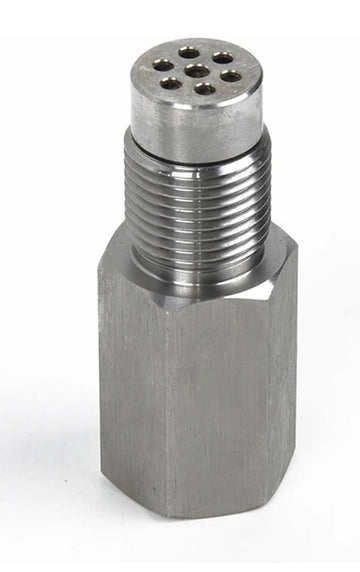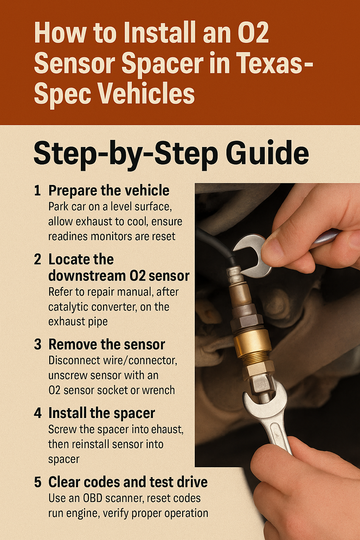Fix P0420 Fast: Do O2 Sensor Spacers Really Work?
Summary
Dealing with a P0420 trouble code? Oxygen sensor spacers, also called O2 sensor extenders or adapters, are a popular workaround. This article explores how and when they work, installation tips, and the legal risks you need to know — especially in states like California. Learn how to fix P0420 fast without making costly mistakes.
Table of Contents
-
What Does the P0420 Code Mean?
-
How Do O2 Sensor Spacers Work?
-
Do They Really Clear the P0420 Code?
-
When Should You Use One?
-
Are O2 Sensor Spacers Legal?
-
How to Install a Spacer Correctly
-
Pros and Cons of O2 Sensor Extenders
-
Legal Alternatives to Spacers
-
Final Thoughts
-
FAQ
-
Related Content
1. What Does the P0420 Code Mean?
P0420 means: “Catalyst System Efficiency Below Threshold (Bank 1)”. This code is triggered when the downstream (post-cat) O2 sensor detects that your catalytic converter isn’t working efficiently.
Common symptoms:
-
Check engine light stays on
-
Failed emissions test
-
Reduced fuel economy
-
Sulfur or rotten egg smell from exhaust
2. How Do O2 Sensor Spacers Work?
O2 sensor spacers move the downstream sensor slightly out of the direct exhaust flow. This reduces the sensor's exposure to emissions gases, tricking the ECU into thinking the catalytic converter is still functioning properly.
They come in different forms:
-
Straight spacers
-
Angled spacers (for tight spaces)
-
Mini catalytic converters (contain a small catalyst element)
3. Do They Really Clear the P0420 Code?
In many cases — yes.
If your catalytic converter is still somewhat functional or you're using a high-flow aftermarket cat, a spacer can prevent the downstream O2 sensor from triggering the P0420 code.
However, they will NOT work if:
-
The cat is completely gutted or missing
-
The upstream O2 sensor is also faulty
-
You have major exhaust leaks
4. When Should You Use One?
Use a spacer if:
-
You recently installed a high-flow or aftermarket catalytic converter
-
Your car triggers P0420, but all other systems are working fine
-
You're trying to pass emissions in a non-strict state
Avoid using one if:
-
You're subject to CARB or California emissions laws
-
Your cat is completely shot or missing
-
You plan to sell the car and want to stay compliant
5. Are O2 Sensor Spacers Legal?
In most cases — no.
Spacers are often considered a form of emissions tampering. While they are sold for "off-road use only," using one on a street-driven vehicle is illegal in states that follow CARB (California Air Resources Board) guidelines.
States with strict laws:
-
California
-
New York
-
Colorado
-
Washington
-
Others with CARB-compliance
Always check your local laws before installing one.
6. How to Install a Spacer Correctly
Tools You Need:
-
Oxygen sensor socket
-
Penetrating oil or anti-seize
-
Torque wrench
-
OBD2 scanner
Steps:
-
Locate the downstream O2 sensor
-
Unplug and remove the sensor
-
Thread the spacer into the exhaust bung
-
Reinstall the sensor into the spacer
-
Clear the code using your OBD2 scanner
After a few drive cycles, the system should show a "ready" status and the check engine light should stay off — if the spacer works.
7. Pros and Cons of O2 Sensor Extenders
Pros:
-
Inexpensive DIY fix
-
Often effective for mild catalytic issues
-
Helps pass readiness monitors temporarily
Cons:
-
Not a permanent fix
-
May be illegal depending on your state
-
Can hide real emissions issues
8. Legal Alternatives to Spacers
If you want to stay legal and still fix P0420:
-
Use a CARB-compliant catalytic converter
-
Replace faulty O2 sensors
-
Fix exhaust leaks
-
Use fuel system cleaner to restore cat efficiency
Some software tunes (with legal disclaimers) can also help manage downstream sensor behavior — but always check your local emissions laws.
9. Final Thoughts
O2 sensor spacers can be a fast, low-cost way to clear a stubborn P0420 code — but they come with limitations and legal concerns. They’re not a long-term fix or a substitute for a working catalytic converter. Use them only when appropriate, and never in states with strict emissions laws.
For high-quality spacers and extenders, visit our shop at Ghaly Motor Parts.
10. FAQ
Q: Will a spacer fix my P0420 permanently?
A: No — it’s a temporary workaround.
Q: Can I pass emissions with a spacer?
A: In some states, yes. In CARB-compliant states, no.
Q: Can I install one myself?
A: Yes — it’s a simple DIY job.
Q: Are mini catalytic spacers better?
A: Yes — they often work more reliably than basic extenders.
11. Related Content

![ Fix P0420 Fast: Do O2 Sensor Spacers Really Work? [Legal Tips Inside]](http://ghalysmotorparts.com/cdn/shop/articles/ChatGPT_Image_Oct_10_2025_10_40_32_AM.png?v=1760118069&width=360)
![Do O2 Sensor Spacers Really Help Clear the P0420 Code? [Expert Guide]](http://ghalysmotorparts.com/cdn/shop/articles/ChatGPT_Image_Oct_9_2025_09_28_33_PM_654c1798-c0d4-428f-a5b6-f20b95661b54.png?v=1760129952&width=360)


